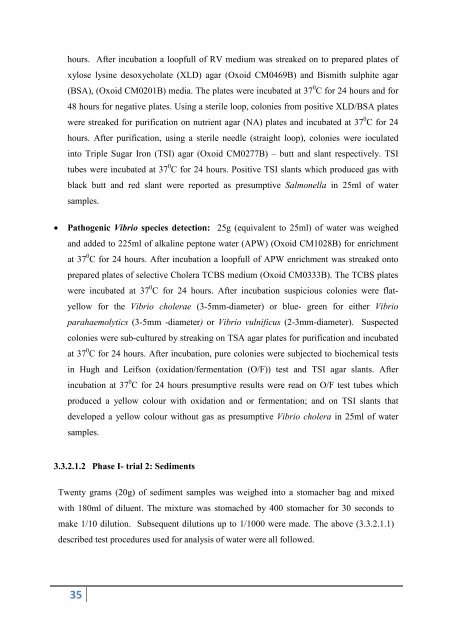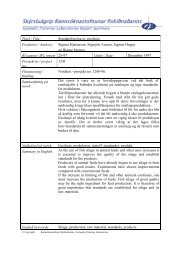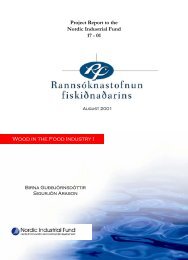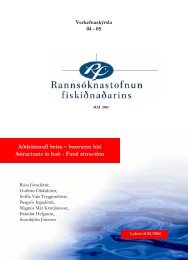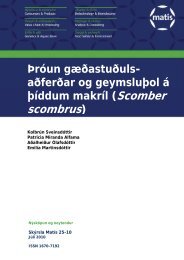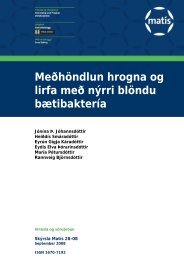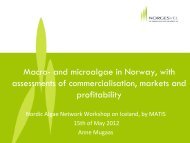Microbiology and Spoilage Trail in Nile Perch (Lates niloticus), Lake ...
Microbiology and Spoilage Trail in Nile Perch (Lates niloticus), Lake ...
Microbiology and Spoilage Trail in Nile Perch (Lates niloticus), Lake ...
You also want an ePaper? Increase the reach of your titles
YUMPU automatically turns print PDFs into web optimized ePapers that Google loves.
hours. After <strong>in</strong>cubation a loopfull of RV medium was streaked on to prepared plates of<br />
xylose lys<strong>in</strong>e desoxycholate (XLD) agar (Oxoid CM0469B) <strong>and</strong> Bismith sulphite agar<br />
(BSA), (Oxoid CM0201B) media. The plates were <strong>in</strong>cubated at 37 0 C for 24 hours <strong>and</strong> for<br />
48 hours for negative plates. Us<strong>in</strong>g a sterile loop, colonies from positive XLD/BSA plates<br />
were streaked for purification on nutrient agar (NA) plates <strong>and</strong> <strong>in</strong>cubated at 37 0 C for 24<br />
hours. After purification, us<strong>in</strong>g a sterile needle (straight loop), colonies were ioculated<br />
<strong>in</strong>to Triple Sugar Iron (TSI) agar (Oxoid CM0277B) – butt <strong>and</strong> slant respectively. TSI<br />
tubes were <strong>in</strong>cubated at 37 0 C for 24 hours. Positive TSI slants which produced gas with<br />
black butt <strong>and</strong> red slant were reported as presumptive Salmonella <strong>in</strong> 25ml of water<br />
samples.<br />
• Pathogenic Vibrio species detection: 25g (equivalent to 25ml) of water was weighed<br />
<strong>and</strong> added to 225ml of alkal<strong>in</strong>e peptone water (APW) (Oxoid CM1028B) for enrichment<br />
at 37 0 C for 24 hours. After <strong>in</strong>cubation a loopfull of APW enrichment was streaked onto<br />
prepared plates of selective Cholera TCBS medium (Oxoid CM0333B). The TCBS plates<br />
were <strong>in</strong>cubated at 37 0 C for 24 hours. After <strong>in</strong>cubation suspicious colonies were flat-<br />
yellow for the Vibrio cholerae (3-5mm-diameter) or blue- green for either Vibrio<br />
parahaemolytics (3-5mm -diameter) or Vibrio vulnificus (2-3mm-diameter). Suspected<br />
colonies were sub-cultured by streak<strong>in</strong>g on TSA agar plates for purification <strong>and</strong> <strong>in</strong>cubated<br />
at 37 0 C for 24 hours. After <strong>in</strong>cubation, pure colonies were subjected to biochemical tests<br />
<strong>in</strong> Hugh <strong>and</strong> Leifson (oxidation/fermentation (O/F)) test <strong>and</strong> TSI agar slants. After<br />
<strong>in</strong>cubation at 37 0 C for 24 hours presumptive results were read on O/F test tubes which<br />
produced a yellow colour with oxidation <strong>and</strong> or fermentation; <strong>and</strong> on TSI slants that<br />
developed a yellow colour without gas as presumptive Vibrio cholera <strong>in</strong> 25ml of water<br />
samples.<br />
3.3.2.1.2 Phase I- trial 2: Sediments<br />
Twenty grams (20g) of sediment samples was weighed <strong>in</strong>to a stomacher bag <strong>and</strong> mixed<br />
with 180ml of diluent. The mixture was stomached by 400 stomacher for 30 seconds to<br />
make 1/10 dilution. Subsequent dilutions up to 1/1000 were made. The above (3.3.2.1.1)<br />
described test procedures used for analysis of water were all followed.<br />
35


